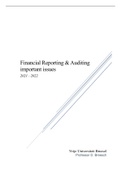Summary
Financial Reporting & Auditing - little summary
- Course
- Institution
This is a good little summary for the subject matter to know in relation with the exam. Note that this alone will not be enough and it only serves to remind you of the main lines. It concerns the important issues.
[Show more]



